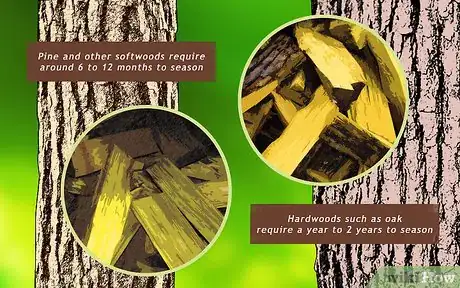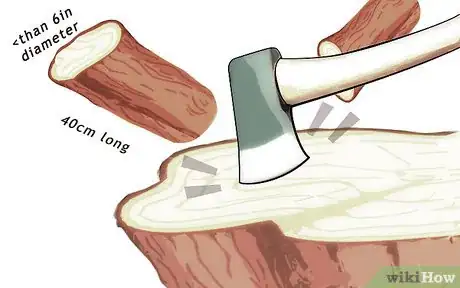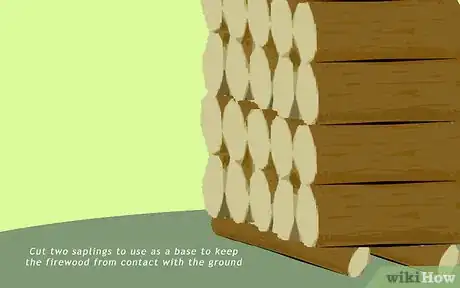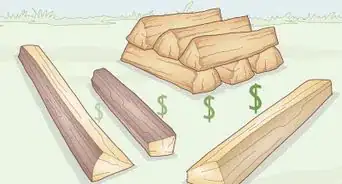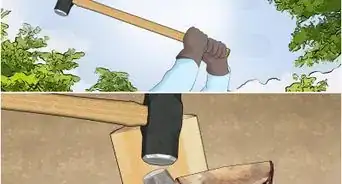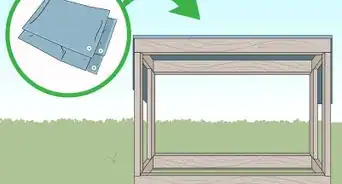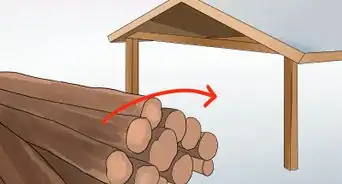wikiHow is a “wiki,” similar to Wikipedia, which means that many of our articles are co-written by multiple authors. To create this article, 25 people, some anonymous, worked to edit and improve it over time.
wikiHow marks an article as reader-approved once it receives enough positive feedback. This article received 15 testimonials and 95% of readers who voted found it helpful, earning it our reader-approved status.
This article has been viewed 1,077,395 times.
Learn more...
Freshly chopped firewood has up to 50% water content and won't burn in your fireplace. First, you must let the firewood season (dry), which allows the moisture to escape––the drier the wood, the cleaner the burn. When the wood gets down below 20% water content, it's ready to burn.[1] Burning unseasoned (green) or even partially seasoned wood in your stove or fireplace will cause creosote build-up in your chimney, which can lead to a chimney fire at the worst, and a lack of fire or a roomful of smoke at best. Every homeowner reliant on wood should know how to season wood.
Steps
-
1Before drying, know the properties of your wood. The duration of seasoning depends on the wood and for deciduous trees, when the tree was felled. The sap of deciduous trees moves to the roots in the winter, so such trees felled in winter have a much lower moisture content to begin with, and so will be seasoned more quickly. In general, pine and other softwoods require around 6 to 12 months to season, while hardwoods such as oak require a year to 2 years.[2] However, this rule of thumb has exceptions, so knowing the tree type and its water content is important.
- Surface water will usually evaporate quickly; the concern is the moisture content within the wood.
- Wood such as shagbark hickory, cherry and black locust will gain little benefit from air drying, as they have low moisture content. On the other hand, wood from such trees as hemlock, cottonwood, American elm and sycamore will benefit from long drying times. Many other tree types are variable.[3]
- Importantly, there isn't any point seasoning wood longer than it needs to be. Over-dried wood will have less energy as volatile esters in the wood evaporate. These waxy substances contain a great deal of heat energy, so it is a mistake to think that longer is necessarily better.
- A special instrument can be hired or purchased that tests the moisture content of wood (usually known as a "wood moisture test meter" or similar).
-
2Gather and stack wood at the right time of year. With the exception of wanting to gather deciduous trees when their sap is lowest during winter, gathering and seasoning wood during the summer season makes good sense because you can take advantage of the warm weather to start drying out the wood. In areas with little rainfall during summer, open air storage is also a viable option; any rain that does fall will usually replace sap and as the water evaporates faster in the heat, the fuel will dry faster.[2]Advertisement
-
3Chop the wood in readiness for storage.[4] It's best to get the pieces down to no more than 6-8 inches (15cm-20cm) in diameter. Eighteen inches (45cm) long is a common size, though 16 inches (40cm) is the correct length for a face cord and will fit better in smaller stoves.
-
4Store the wood outdoors.[5] Do not store wood inside; if there are termites, you don't want them getting at your house!
-
5Stack the wood so it isn't sitting directly on the ground or right up against a wall.[6] If you don't have a woodshed, cut two saplings to use as a base to keep the firewood from contact with the ground. Pallets are also a great alternative.
- If you don't have or don't want to make side supports, you can stack the ends by turning the direction of wood 90 degrees with each layer and the end stacks will be self supporting.
-
6Allow space between the stack and a wall to allow air to move. Air circulation is an essential part of the seasoning process, to ensure that the wood dries. Ideally, you would have a moisture barrier such as a tarp below the wood, and/or have it spaced up off the ground to allow air flow.[7]
-
7Ensure that the top of the wood is covered to allow rain (or snow) to run off without soaking the wood. However, keep the ends of the stack uncovered to allow air to circulate and moisture to escape.
- Bark acts like a lid on firewood, offering natural protection.[2] On split wood, stack the wood with the bark on the bottom to allow the wood to dry faster. If you are storing the wood without cover, stacking with the bark on top will prevent some of the rain from soaking into the wood.
- There are two theories on the covering of wood during the seasoning process and you must decide for yourself which theory you wish to follow. One theory is that already stated––cover the wood to prevent the rain and snow from entering the center of the stack and gathering there. However, within the firewood community, another theory holds that you do not have to cover your wood at all, ever. Just leave it out there in the weather and it will season just as well as if you covered it. This theory has its supporters and the they are quite sure it works just as well as covering your pile. Perhaps divide your wood and try an experiment with both ways.
-
8Check for wood dryness. You can use the wood moisture test meter as mentioned earlier, if you have access to one. Alternatively, try these simple test:[2]
- 1. Pick two pieces of wood that you think is dry. Knock the two pieces together. If you hear more of a "ring" than a "thud", then it's probably dry.
- 2. Also, check for radial cracks at the ends of the wood, which indicate dryness.
- 3. Burn a piece on a roaring fire base. If three of the sides begin to burn within 15 minutes, the fuel is dry.
Community Q&A
-
QuestionShould I dry oak before splitting it?
 Community AnswerI've just been splitting it before drying. I think that it will dry faster that way and it's easier to stack.
Community AnswerI've just been splitting it before drying. I think that it will dry faster that way and it's easier to stack. -
QuestionDoes a standing dead tree need to be seasoned as long as a green tree?
 Community AnswerNo. I have a lot of dead standing spruce, and once cut, it only takes a day or so to dry. In some cases, the wood can be burned immediately.
Community AnswerNo. I have a lot of dead standing spruce, and once cut, it only takes a day or so to dry. In some cases, the wood can be burned immediately. -
QuestionAre maple and cherry considered hardwoods?
 Community AnswerHardwood is wood from dicot angiosperm trees. Hardwood contrasts with softwood (which is from gymnosperm trees). A gymnosperm is a plant that has seeds unprotected by an ovary or fruit. Gymnosperms include the conifers, cycads, and ginkgo. Cherries, very obviously, are not gymnosperms. The seed of a cherry is protected by the cherry fruit. Maples are a little more confusing. However, it is also important to know that angiosperms have broad leaves which change color or drop during the winter, and maples do that. So, to answer your question, both maple and cherry are considered hardwood.
Community AnswerHardwood is wood from dicot angiosperm trees. Hardwood contrasts with softwood (which is from gymnosperm trees). A gymnosperm is a plant that has seeds unprotected by an ovary or fruit. Gymnosperms include the conifers, cycads, and ginkgo. Cherries, very obviously, are not gymnosperms. The seed of a cherry is protected by the cherry fruit. Maples are a little more confusing. However, it is also important to know that angiosperms have broad leaves which change color or drop during the winter, and maples do that. So, to answer your question, both maple and cherry are considered hardwood.
Warnings
- Never completely cover the wood with a tarp. It will serve to trap the moisture that is escaping from the wood and will rot the wood rather than dry it. The moisture must be allowed to escape the pile.⧼thumbs_response⧽
- Do not stack wood higher than your own height. Being hit on the head by a log falling can cause serious injury.⧼thumbs_response⧽
- Do not burn unseasoned (green) or even partially seasoned wood in your stove or fireplace as this will cause creosote build-up in your chimney, which could lead to a chimney fire. Moreover, it may not even burn at all.⧼thumbs_response⧽
- Be careful chopping wood. It's easier than you think to injure yourself with that axe. (Actually, accidents with axes are one of the leading causes of injuries in homes where homeowners provide their own wood.)⧼thumbs_response⧽
- When chopping wood, wear goggles and baseball catcher's shin guards to protect yourself from the axe entering your shins on a missed swing.⧼thumbs_response⧽
- Some woods naturally spit a lot, even after seasoning. Take additional care with such woods to avoid dry materials and fabrics from catching on fire due to sparks.⧼thumbs_response⧽
- Avoid using endangered species of trees for wood, as well as avoiding any native species that are on the decline.⧼thumbs_response⧽
- Be wary of snakes, spiders and/or other potentially dangerous creatures taking up residence in your woodpile. Never put your hand into a pile unprotected––purchase decent leather or other gloves and move wood from the edges rather than sticking hands into holes.⧼thumbs_response⧽
- Never stack rotten wood. There is no point keeping it, as it will provide very little heat when burned.⧼thumbs_response⧽
References
- ↑ https://www.motherearthnews.com/homesteading-and-livestock/self-reliance/seasoning-firewood-tips-ze0z1411zdeh
- ↑ 2.02.12.22.3The Natural Parent, The Burning Issue…, pp. 42-43, Issue Autumn 2012
- ↑ Abigail Gehring, The Back to Basics Handbook, p. 67, (2011), ISBN 978-1-61608-261-1
- ↑ https://www.motherearthnews.com/homesteading-and-livestock/self-reliance/seasoning-firewood-tips-ze0z1411zdeh
- ↑ https://thisnzlife.co.nz/5-tips-to-drying-firewood/
- ↑ https://www.firewood-for-life.com/how-to-season-firewood.html
- ↑ https://www.firewood-for-life.com/how-to-season-firewood.html
